ASRock CoreHT 252B Review
by Ganesh T S on September 2, 2011 3:45 AM EST- Posted in
- HTPC
- Intel
- ASRock
- Media Streamer
The ASRock CoreHT 252B is basically a notebook solution. It wouldn't make sense to compare it with full blown desktop Sandy Bridge solutions (or for that matter, any system with a power consumption of more than 100W). In the comparative benchmarks provided in the rest of this review, we will provide the scores obtained by the CoreHT 252B and other similar SFF HTPC solutions.
Windows Experience Index
This metric is often considered meaningless, but we feel it serves as an indicator of what could be the bottleneck in a system for pre-built HTPCs. Surprisingly, it is not the HD 3000 GPU which is responsible for the score of the system. Both the RAM and the hard disk weigh in at 5.9.

The Core i5-2520M supports DDR3-1600 for its DRAM. ASRock could have used the higher speed DRAM and / or a SSD as the primary disk in order to improve this score.
USB 3.0 Performance
The first generation Core 100 HTPC couldn't provide full USB 3.0 performance due to limitations in the HM55 chipset. Compared to the 6 PCI-Express ports in the HM55 chipset, we have 8 in the HM65. This makes it possible for the USB 3.0 controllers to provide full performance.
The CoreHT 252B provides four USB 3.0 ports, two at the front and two at the rear. Renesas (NEC) continues to provide the USB 3.0 controllers for ASRock's mid-range HTPCs. We hooked up OCZ's Enyo 128 GB USB 3.0 external SSD (which has received glowing reviews everywhere with upto 200 MBps read and 190 MBps write speeds) to the various USB 3.0 ports of the CoreHT 252B. Using the Random Access feature of HD Tune Pro 4.50, we obtained the average read and write speeds for random sized accesses to random locations on the SSD. The performance metrics are graphed below.
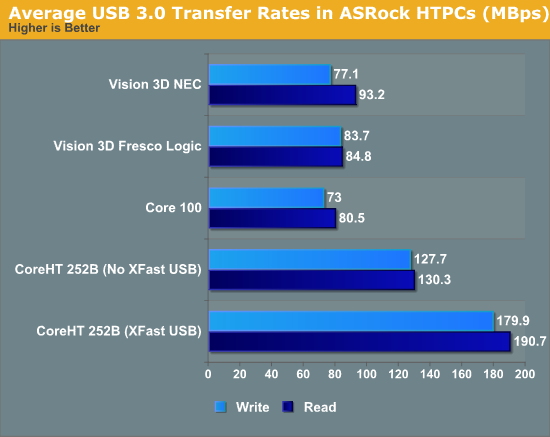
At the outset, it is clear that the USB 3.0 performance improves drastically over the Core 100 and the Vision 3D. ASRock supplies XFast USB, a driver level feature to improve USB performance. As is evident from the above graph, disabling XFast USB seems to have a huge detrimental effect on the performance. In any case, it is advisable for the users to keep XFast USB enabled to get the best out of their system.
Miscellaneous Performance Metrics
The graphs below give an idea of where the ASRock CoreHT 252B stands with respect to performance when compared with other SFF HTPCs. PCMark Vantage's PCMark score gives a general idea of the system's capability.
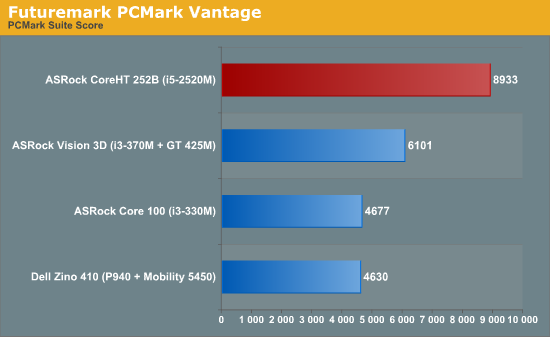
We also ran the 3D Mark Vantage and 3D Mark 06 benchmarks and the graphs below show how the Intel HD Graphics 3000 fares when compared to the GPU capabilities of other pre-built SFF HTPCs.
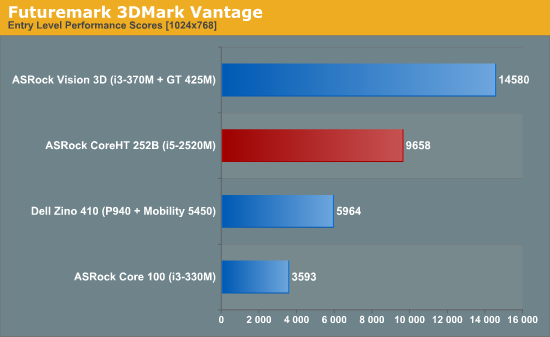

Intel HD Graphics 3000 manages to beat the Mobility 5450 easily in the synthetic benchmarks. In terms of the PC-centric scores, the CoreHT is miles ahead of the SFF HTPCs from last year. This goes on to prove that the bar for the mid-range HTPC just keeps getting higher.
In addition to the above synthetic benchmarks, a couple of commong HTPC workloads were also benchmarked. We have some data on the x264 encoding performance using the i5-2520M. Note that we are unable to utilize QuickSync for this test because QuickSync is unable to provide any for of support for accelerating x264 encode.
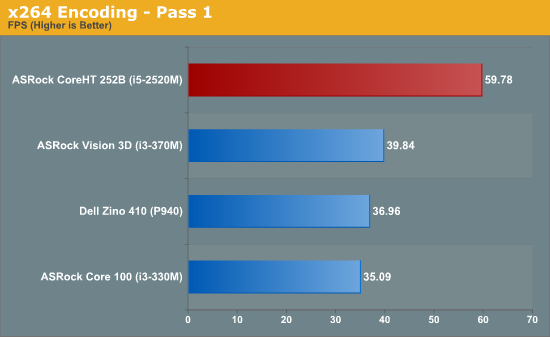
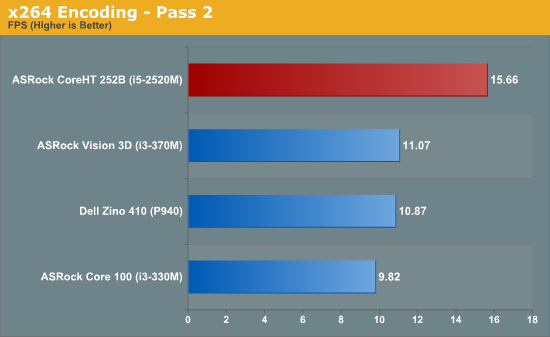
An estimate of how well WinRAR performs, particularly with respect to processing split archives, wraps up this section. To evaluate this, we take a 4.36 GB MKV file, compress it in the 'Best' compression mode into a split archive (97.1 MB each), which results in 44 files on the hard disk. The time taken to decompress this split archive is then recorded. The performance in this benchmark is heavily influenced by the hard disk in the system. It looks like both the CoreHT 252B and the Vision 3D are close to the best possible results in this benchmark, thanks to their 7200 rpm disk.
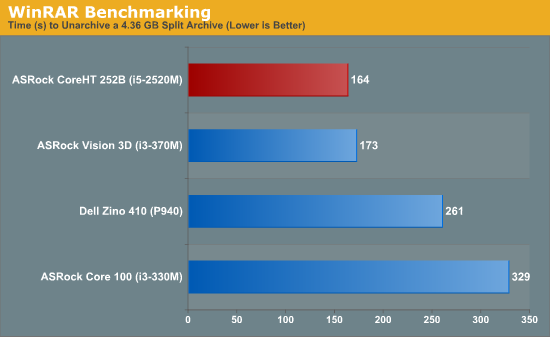
We have deliberately refrained from dealing with gaming benchmarks in this review. Serious gaming enthusiasts know that Intel's integrated GPU is not going to pass muster. For readers interested in finding out how good Intel's HD Graphics 3000 fares in our gaming benchmark, I would suggest looking at Jarred's review of the Asus K53E, which houses a i5-2520M and 6 GB RAM (compared with the i5-2520M and 4GB RAM of the CoreHT 252B that we are dealing with here).










54 Comments
View All Comments
uncola - Friday, September 2, 2011 - link
intel really needs to get their shit together re: dxva and hardware decoding for videovlado08 - Friday, September 2, 2011 - link
First I want to tank you Ganesh for the article. Keep the good work!Would you give us some more information please.
Can it play 1080 60p?
There are a lot of camcorders that can record in AVCHD v2.0 (1080 60p 28Mb/s).
What are the temperatures (CPU HDD) inside during idle and 100% load?
Why ASRock don't make CPU fan to blow outside the case as in notebooks?
Can you select RGB or YUV output in new intel drivers?
ganeshts - Friday, September 2, 2011 - link
Yes, it does play 1080p60 without issues (even the Clarkdales and Arrandales can do it).The 1080p60 streams are part of our test suite. But, yet, you are right .. I should have mentioned it.
The HTPC outputs RGB, and there is no obvious way to change it to YUV in the graphics control panel. However, the levels (0-255 / 16-235) can be modified with the Quantization Range option.
I will get back to you on the temperatures in a day.
vlado08 - Friday, September 2, 2011 - link
Thanks Ganesh, is 1080 60p hardware accelerated?ganeshts - Friday, September 2, 2011 - link
Yes, it is.Both 1080p60 and 16 reference frame H.264 videos were able to get DXVA2 hardware acceleration using the Microsoft DTV-DVD decoder.
ganeshts - Friday, September 2, 2011 - link
Here is the temperature info you requested (measured using the AXTU tool for the mobo and the CPU / HD Tune Pro for the hard disk in Celsiuis scale):Idle:
Motherboard : 42
CPU : 44
Hard Disk : 37
Prime95 + Furmark (after 15 minutes of activity):
Motherboard : 48
CPU : 83
Hard Disk : 39
tech6 - Friday, September 2, 2011 - link
I bought a previous generation HT100-BD and it was a fine HTPC but the ASRock service was appaling. The unit had two failed HDMI ports in the first 12 months and the second time ASRock demanded payment to fix it (even tough it was under warranty).As convenient as it may seem, I would go down the DIY route just for the flexibility of being able to fix it yourself.
Rick83 - Friday, September 2, 2011 - link
As paying the Windows Tax for a single purpose/ non-gaming machine is a bit pointless, I wonder how well the hardware in this box cooperates with Linux?I tried to build a HTPC on an older AMD platform and was continually being thwarted by driver issues (WLAN, sound, graphics), but here there actually may be an advantage, as Intel has a developer that manages libva, so their acceleration might work better on linux than DXVA..
Also XBMC has a native linux version which is quite nice and should even boot faster in an optimized system than a Windows system.
Vagn Henning - Friday, September 2, 2011 - link
As you might have noticed, the box ships without Windows. You see, that's the difference between your "Windows tax" and other taxes: You don't have to pay it. You are free to install any other OS. If you stopped pretending otherwise, someone might actually answer your question...Rick83 - Friday, September 2, 2011 - link
Well, the reviewer only used Windows, hence assuming that one pays for it.A Windows-only review is of little help for someone attempting to deploy linux on this box.
If the reviewer implies the windows tax, by not mentioning alternatives, he is the one accepting it, I am merely referring to his point of view.
Also, the alternative to the Windows tax is the Linux tax. The latter can often end up being higher....